
VNU Journal of Science: Education Research, Vol. 41, No. 1 (2025) 94-104
94
Original Article
Inclusive Education: Enhancing Social Integration
and Academic Achievement for Students With and Without
Learning Disabilities Aged 5 to 14
Nguyen Thi Thuy Nam, Huynh Tan*
Nguyen Tat Thanh University, Nguyen Tat Thanh, District 4, Ho Chi Minh, Vietnam
Received 16th May 2024
Revised 22nd November 2024; Accepted 09th December 2024
Abstract: Inclusive education is recognized as essential for fostering the holistic development of
children, irrespective of their abilities or limitations. This paper examines the effects of inclusive
education on students with learning disabilities (SWLD) and students without learning disabilities
(SWOLD) in Southern Vietnam, focusing on its impact on social integration and academic
achievement. The study employs a mixed-methods research design, combining qualitative
interviews with educators and quantitative analysis of student performance data. There are 487
participants, consisting of 132 SWLD and 355 SWOLD. These participants were drawn
from inclusive and non-inclusive schools across various educational levels in southern Vietnam.
Results indicate that inclusive practices significantly enhance social integration, empathy, and
understanding among students. For SWLD, inclusive education leads to improved academic
outcomes, particularly in the early education stages, while SWOLD reports favourable or neutral
effects on academic achievements. However, at the secondary education level, the impact tends to
be neutral or adverse for SWOLD. The research also identifies challenges in Southern Vietnam,
including insufficient funding, inadequate teacher training and limited policy support, which
hinder the effective implementation of inclusive education. Addressing these barriers is crucial for
creating an equitable learning environment for all students in Vietnam.
Keywords: Inclusive education, students with disabilities, social integration, academic achievement,
empathy.
1. Introduction *
In 2018, the United States Individuals with
Disabilities Education Act (IDEA) defined a
_______
* Corresponding author.
E-mail address: htan@ntt.edu.vn
https://doi.org/10.25073/2588-1159/vnuer.4930
specific learning disability as a disorder that
hinders the essential cognitive processes
involved in comprehending and utilizing
language, including speaking, listening,
thinking, reading, writing, spelling, and
mathematical reasoning. This encompasses
conditions such as dyslexia, minimal brain
dysfunction, brain injury, perceptual disabilities

N. T. T. Nam, H. Tan / VNU Journal of Science: Education Research, Vol. 41, No. 1 (2025) 94-104
95
and developmental aphasia. It is important to
note that specific learning disabilities do not
include difficulties primarily caused by
intellectual disability, emotional disturbances,
visual, auditory or motor impairments or
unfavourable environmental, cultural or
economic factors [2]. In 2013, the National
Joint Committee on Learning Disabilities
(NJCLD) distinguished between developmental
learning disability and academic learning
disability. Learning difficulties associated with
developmental issues are identified in young
children attending preschool. They include
problems with attention, memory, language
comprehension, perceptual abilities, motor
skills, cognitive processes and the delayed
acquisition of fundamental skills. Examples of
academic learning disabilities include
deficiencies in reading, writing, spelling and
mathematical proficiency, which are typically
honed during the initial stages of formal
education [4].
The United Nations Educational, Scientific
and Cultural Organization (2008) stated that
inclusive education was a process of supplying
education to all students regardless of their
genders, backgrounds, abilities, characteristics
and learning expectations. It is "central to the
achievement of high-quality education for all
learners and the development of more inclusive
societies” [6]. Inclusive education’s goal is to
provide children with and without disabilities
equal opportunities and educational resources to
foster their development, independence and
social engagement [7].
Ruijs and Peetsma (2010) stated that the
term “inclusive education” refers to the
approach of integrating students with special
needs into regular classroom environments as
opposed to placing them in special education
facilities. To put it another way, it means
integrating special education students into
regular classrooms and giving them the support
resources they require there, rather than
relocating them to receive support elsewhere.
Students' interactions with peers provide both
students with learning disabilities (SWLD) as
well as students without learning disabilities
(SWOLD) with critical opportunities to
enhance their social and cognitive development
[9]. These interactions help SWLD feel less
isolated in their communities by positively
impacting their psychological well-being and
showing a better sense of integration into the
community.
In addition, various views of educational
organizations are the root causes of differences
in the application of inclusive education.
Politicians, academics and practitioners,
therefore, have different opinions about
inclusive education and the roles and
capabilities that schools should play in
promoting its success [10]. Therefore, exploring
inclusive education in educational contexts has
several practical and scholarly obstacles. An
institutionalized framework with mechanisms
that sustain exclusion for some students has
been established as a result of a variety of
factors, including the creation of policies,
administrative supervision, instructional
practices, student interactions and all facets of
educational communication [11].
Vietnam has also been trying to integrate
inclusive education into schools, in order to
benefit Vietnamese children with disabilities,
with the desire to provide them with the best
possible development and help them integrate
better into modern society. Since the early
1990s, the Vietnamese government has
established policies to ensure that children with
disabilities have access to education. This focus
is currently reflected in the national plan titled
"Inclusive Education during the period of 2018
- 2020," which aims to enhance accessibility
and improve the quality of education for
individuals with disabilities. The plan
prioritizes ensuring that people with disabilities
receive equitable, high-quality education [12].
By 2020, the objectives included providing
inclusive, quality education to at least 70% of
preschool-age children with disabilities, as well
as the broader population of individuals with
disabilities. Additionally, at least 50% of
managers, teachers and staff involved in
educating people with disabilities received
training, with 40% of provinces and cities

N. T. T. Nam, H. Tan / VNU Journal of Science: Education Research, Vol. 41, No. 1 (2025) 94-104
96
establishing centers to support the development
of inclusive education. Moreover, all provinces,
regions, cities and educational institutions are
expected to implement legal provisions
regarding education accessibility. Vietnam has
also actively engaged in international
commitments and regional inclusive education
goals, establishing a strong legal framework at
multiple levels to support these efforts [12].
An investigation into the implementation of
inclusive education was carried out across
several schools in southern Vietnam. It aimed
to assess the standard of inclusive learning in
both Southern Vietnam and the whole country.
Additionally, the study sought to gain insights
into the accomplishments and challenges
encountered during the adoption of inclusive
education practices within the Vietnamese
educational system. The results indicate that the
integration of inclusive education in Vietnam
encounters numerous challenges. A significant
number of Vietnamese children with disabilities
are not properly exposed to inclusive education.
These students are educated separately in
special schools for students with disabilities,
where they receive tailored instruction to
address their needs and prepare them for their
future careers. However, being isolated from
the regular educational environment with non-
disabled students makes it difficult for them to
communicate and integrate into society as a
whole. Consequently, SWLD in Vietnam
should be educated in general settings alongside
SWOLD to enhance their self-esteem, integrate
better into society and develop the necessary skills
for their future. Besides, it is obvious that the
successful implementation of inclusive education
in the Vietnamese context requires effort from all
leaders, educators and collaboration from families
of children with disabilities.
2. Literature Review
2.1. Why Is Inclusive Education Important?
Chamberlain et al., (2007) argued that
inclusive education could enhance learning and
development for both SWLD and SWOLD if
they are given opportunities to receive more
appropriate support, learn from age-appropriate
models, interactional partners and experience
collaboration.
The goal of inclusive education is to
guarantee that every student has equal access to
opportunities for high-quality education. The
primary goal of educational institutions should
be to foster holistic growth in students,
addressing their intellectual, physical, social,
personal and vocational dimensions. This
approach enables SWLD to gain the skills
necessary for independence and a smooth
transition into society. This reduces their
perception of differences, limitations and
feelings of inadequacy resulting from their
disability [14]. The advantages of inclusive
education are numerous and include
institutional changes to improve educational
accessibility as well as the development of
robust community engagement. The author also
highlights benefits, including enabling flexible
learning settings that are customized to
students' needs and promoting community
engagement to foster significant relationships
among families, communities and educational
institutions. Vaghrodia and Patel (2022) also
indicate that incorporating students with
disabilities into a conventional educational
environment demonstrates the importance of
inclusive education in fostering an atmosphere
that embraces diversity and cultivates
fundamental virtues like empathy and kindness.
Recognizing the significance of inclusive
education for societal development, Vietnam
has initiated efforts to raise public awareness
about educational equality and to advocate for
support for children with disabilities. Inclusive
education in Vietnam began over 30 years ago,
with significant developments starting in 1991
when the National Center for Special Education
(NCSE) received funding from Catholic Relief
Services (CRS) to establish the first inclusive
education model in two northern districts. By
1992, nearly 1,000 of the 1,078 students with
mild, moderate and severe disabilities were
enrolled in preschool and general education
classes in Thuong Tin and Tu Liem districts.
That same year, the National Assembly

N. T. T. Nam, H. Tan / VNU Journal of Science: Education Research, Vol. 41, No. 1 (2025) 94-104
97
approved a new Constitution, which highlighted
that "The government and society create
conditions for children with disabilities to
receive appropriate cultural and vocational
education. In 2007, Vietnam signed the
International Convention on the Rights of
Persons with Disabilities, becoming the first
nation in Asia and the second globally [16].
The country's commitment to ensuring
equal rights and access to education for these
children is reflected in a range of legal
documents. This includes the 1946 Constitution
of the Democratic Republic of Vietnam, as well
as the Constitutions of 1959, 1980, 1992 and
2013, all of which emphasize the protection of
civil rights and the prohibition of discrimination
and mistreatment. Furthermore, various laws
contain specific chapters, sections or provisions
dedicated to individuals with disabilities, detailing
policies, assistance and care. Vietnam has also
established a comprehensive legal framework that
addresses the rights of children with disabilities
and their access to education [12].
Since having well-timed strategies and
effective implementation, inclusive education in
Vietnam has begun to yield positive results.
Awareness and support for children with
disabilities within the community have
significantly increased. Community members
surveyed and interviewed by the evaluation
team indicated that participation in project
activities led to a noticeable shift in their
perception. Caring for and supporting all
children, including those with disabilities,
became a shared community responsibility and
priority. For example, local leaders organized
public awareness campaigns through
newspapers and radio stations, while
community groups such as women's and
farmers' unions collaborated to raise funds for
the education of children with disabilities.
Additionally, notable achievements from the
early stages of inclusive education include
substantial upgrades to local infrastructure,
revised age requirements and ensuring that no
more than 5% of students in a class have
disabilities and that these students are no more
than three years older than their peers. There
have also been significant improvements in
teaching quality and attitudes towards children
with disabilities, along with increased family
support and involvement. Overall, the
educational experience for children with
disabilities has markedly improved since the
introduction of inclusive education [13].
2.2. Impact of Inclusive Education on SWLD
Education is commonly acknowledged as a
tool for societal levelling owing to its capacity
to nurture both cognitive and personal
development [6]. However, it has long been an
issue at educational institutions across the globe
for varied student groups and underprivileged
communities-such as those with disabilities,
those from different ethnic backgrounds and
people from lower socioeconomic status - to be
excluded. In response to this challenge, the
notion of inclusive education has emerged as a
vital agent of change in contemporary
educational practices. By affirming the
entitlement of every individual regardless of
their diversities, to an equitable and high-
quality educational experience, inclusive
education signifies an essential shift in
educational paradigms [14].
According to UNESCO, "Every learner is
important and equally important," which
implies that every child can develop into a
wonderful person, regardless of their level of
disability. The achievements of Stephen
Hawking demonstrate that a disability does not
preclude a person from achieving success and
making important contributions to science.
Regardless of a person's background or
characteristics, schools should prioritize
fostering an inclusive learning environment and
appreciating each person for their contributions.
This will guarantee equity in the educational
system and promote a sense of community.
Lerner (2003) observed that SWLD either
had intellectual disabilities or behaviour
disorders or both, so they had difficulties with
processing skills such as memory and thinking
as well as visual and auditory perception. As a
result, they had problems learning in at least
one subject such as reading, math or writing.

N. T. T. Nam, H. Tan / VNU Journal of Science: Education Research, Vol. 41, No. 1 (2025) 94-104
98
Lerner (2003) also stated that there have been
studies indicating that inclusive education has a
positive impact on the social outcomes of
SWLD. He asserted that if SWLD studied in
general settings, they would have opportunities
to observe, imitate and reflect on the actions
and behaviours of other typically developing
students. As a result, they could learn and
develop their social skills better. Rafferty,
Boettcher and Griffin (2001) found that
children with severe disabilities performed
better in language improvement and social
skills in inclusive classrooms which are a more
positive and caring environment than in
segregated classrooms. In the study of Rea and
colleagues in 2002 which examined the impact
of inclusion on SWLD's academic achievement,
they found that SWLD performed better in
language arts, mathematics, science and social
studies and they were more likely to improve
their self-esteem in the classroom.
In addition, teacher efficacy refers to the
beliefs or views that teachers have about their
ability to teach students with various needs and
to support the students’ desired improvement.
Previous studies have consistently highlighted
teacher efficacy as a critical factor that
separates competent teachers from those who
are having difficulty delivering instruction [6].
Furthermore, Skaalvik and Skaalvik (2014)
explained that there was a negative relationship
between teacher efficacy and emotional
exhaustion and that higher teacher efficacy
levels are associated with lower emotional
exhaustion. All of these studies pointed to a
tendency for teachers who had high levels of
teacher efficacy to experience lower levels of
psychological discomfort.
In another study, Sree Priya (2016) stated
that the goal of educational programs in schools
should be to support students' comprehensive
development, which includes intellectual,
physical, social, personal and career aspects.
This will help SWLD gain the skills they need
to live independently and adjust to real-world
situations, reducing feelings of inadequacy,
limitations and differences due to their
disabilities. Parveen and Qounsar's (2018) study
illustrated that SWLD exhibit improved peer
interaction and communication abilities when
engaged with non-disabled peers. Inclusive
educational environments foster social learning
opportunities, facilitate the formation of
positive peer relationships and provide valuable
communication models for SWLD.
Consequently, the research underscores the role
of inclusive education in fostering a supportive
and enriching learning atmosphere for students
with impairments, thereby positively
influencing their social and communicative
growth. The table below is a summary of the
impact of inclusive education on SWLD
according to four aspects: social outcomes,
academic outcomes, teacher efficacy, and
comprehensive development.
Table 1. Impact of Inclusive Education on Students with Learning Disabilities (SWLD)
Aspect
Findings
Social
Outcomes
- Improve peer interaction and communication abilities when engaging with non-disabled peers.
- Inclusive environments foster social learning opportunities, positive peer relationships and
provide valuable communication models.
Academic
Outcomes
- Improve performance in language arts, mathematics, science and social studies.
- Increase likelihood of improved self-esteem in the classroom.
Teacher
Efficacy
- Teacher efficacy is a critical factor in delivering effective instruction to SWLD.
- Higher levels of teacher efficacy are associated with lower levels of emotional exhaustion
and psychological discomfort.
Comprehensive
Development
- Educational programs should support students' comprehensive development, including
intellectual, physical, social, personal and career aspects.
- This approach helps SWLD gain skills for independence and societal adjustment.
E




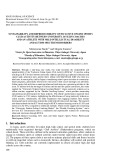

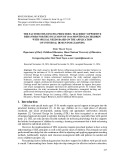


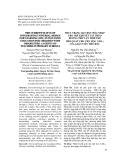




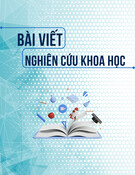

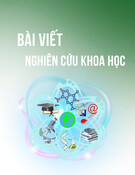

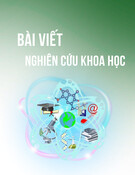


![Định hướng giáo dục STEM trong trường trung học: Tài liệu [chuẩn/mới nhất]](https://cdn.tailieu.vn/images/document/thumbnail/2025/20251124/dbui65015@gmail.com/135x160/25561764038505.jpg)




